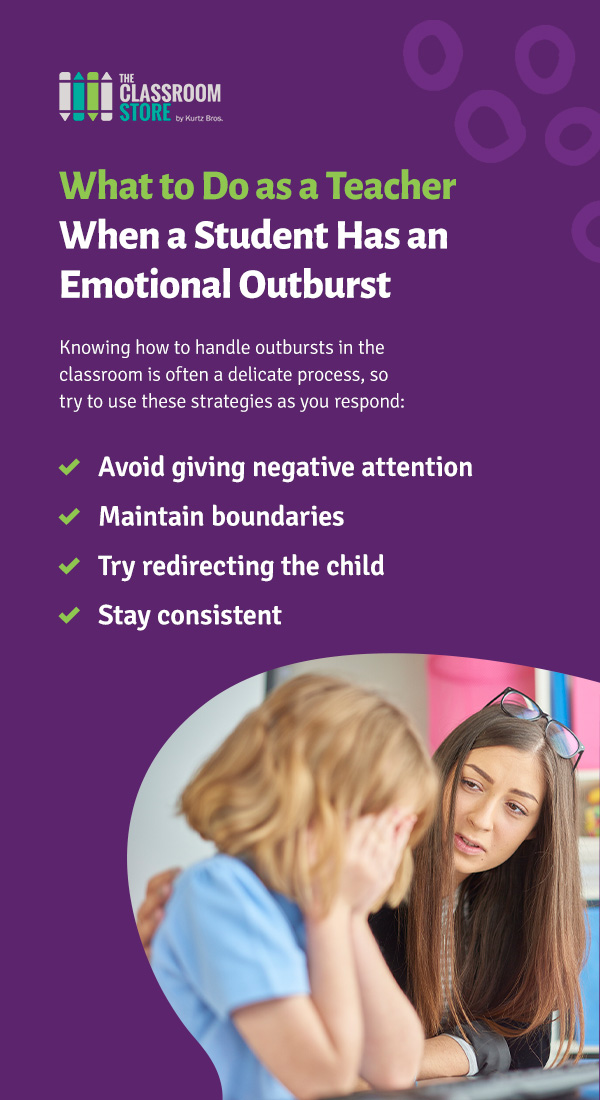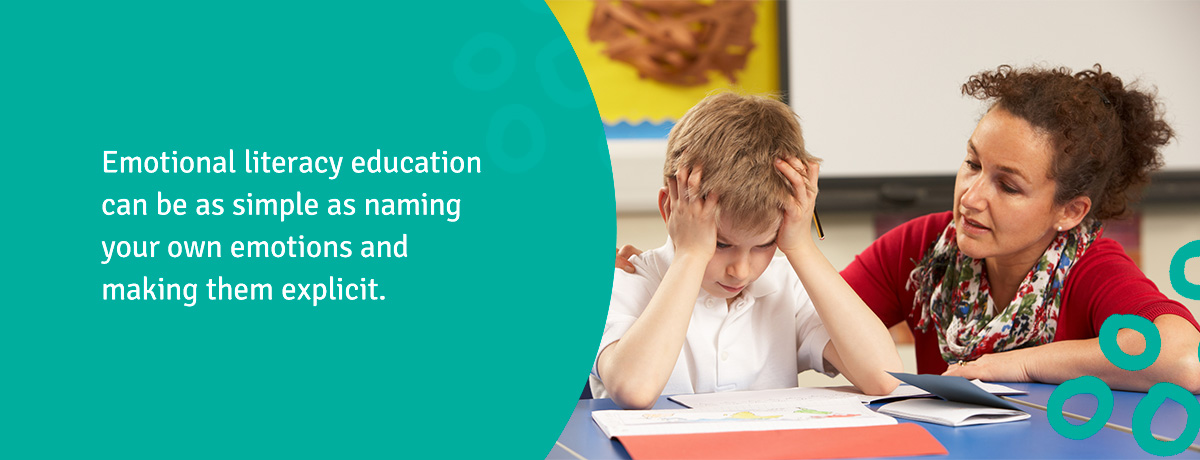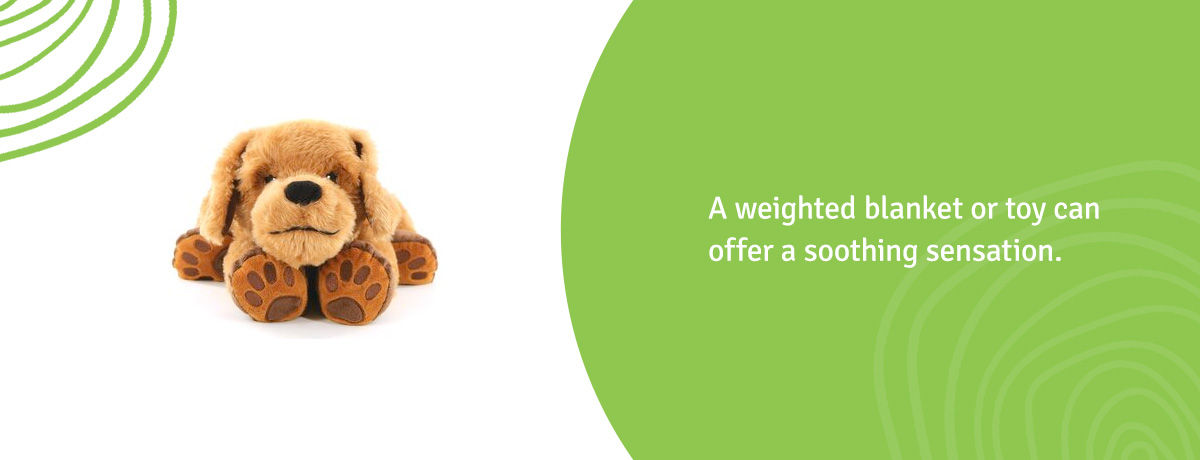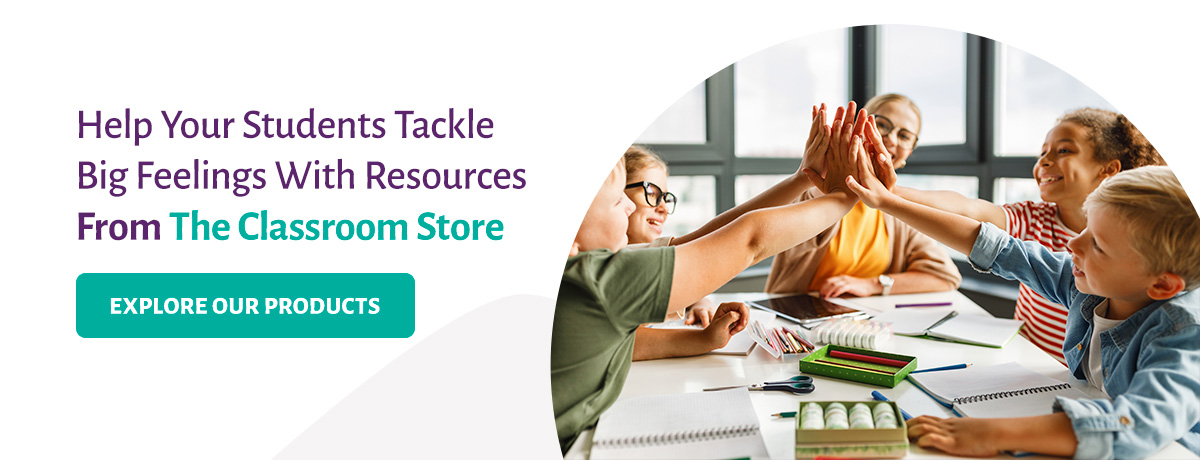The Guide to Managing Emotions in the Classroom

Big feelings are tough to deal with, especially when you’re still learning about them. Emotional skills are nothing short of crucial in the early years, but many children struggle to navigate complicated feelings. They might be prone to outbursts or bottle up their feelings in unhealthy ways. By teaching kids how to work through their feelings, we can help them better adapt to stress and maintain good relationships, leading to stronger social-emotional development.
From constructively responding to outbreaks to building up emotional literacy, educators can make a big difference in helping kids understand their emotions. Because teachers already have a lot on their plates, we’ve put together some actionable tips for tackling emotions in the classroom.
Why Students May Have Emotional Outbursts and a Difficult Time Regulating Emotions
Emotional outbursts can come from many different places and usually signify that the child is frustrated or distressed, perhaps from sensory overload or a negative emotion for which they lack coping skills.
While outbursts often happen to kids without any specific emotional problems, they are particularly common in children dealing with certain disorders, such as anxiety and autism spectrum disorder (ASD). One study found that over 75% of kids with severe temper outbursts also fit the criteria for attention-deficit hyperactivity disorder (ADHD).
Some conditions that commonly involve emotional outbursts include:
- ASD: Kids on the autism spectrum may be prone to outbursts and meltdowns. They can become distressed without consistency and routine, and their communication skills might not allow them to express their emotions, causing them to lash out.
- ADHD: Many kids with ADHD deal with problems related to anger, defiance and sensory processing. When paired with difficulties with impulse control, hyperactivity and transitioning away from fun activities, ADHD poses some opportunities for emotional outbursts.
- Anxiety: Anxiety disorders can present with outbursts during anger or fear, especially when kids don’t know how to cope with a stressful situation. It can activate their fight or flight response and trigger outbursts as a response to their fear.
- Oppositional defiant disorder (ODD) and disruptive mood dysregulation disorder (DMDD): Children with ODD show anger, irritation and argumentative behavior, while those with DMDD often have angry outbursts and depressed or irritable moods. Both conditions can lead to outbursts as kids try to deal with their feelings. During these outbursts, kids may act out and cause problems for the authority figure.
- Learning disorders: If a child has a learning disorder, especially an undiagnosed one, they may be prone to outbursts as they become frustrated, angry or upset by the challenges of school work. They might have an outburst if they don’t know how to deal with their feelings or want to cause a distraction and avoid doing the work.
- Neglect and trauma: Neglect and trauma can make kids feel unsafe and lash out at school. It can affect how they connect to other people and may come with difficulties related to positive thinking and emotional regulation.
- Sensory processing issues: Sensory processing challenges, which can go hand in hand with some of the conditions we’ve discussed, can lead to seemingly random outbursts. A scratchy tag on clothing or a loud air conditioner could be enough to set off a child with sensory processing issues.
Whether a child’s outbursts stem from everyday emotions or one of these conditions, you can often prevent and mitigate outbursts by building up behavioral skills and focusing on strong social-emotional development. Some skills might be focused on specific challenges associated with a diagnosis or trigger, but others benefit all children learning about their emotions.
What to Do as a Teacher When a Student Has an Emotional Outburst

When an outburst happens in the classroom, you have a few tasks ahead of you. You need to keep the class on track, but you also want to make sure the child can deal with their emotions in a healthy way and tackle their problems.
Some adults resort to discipline or giving the child what they want to stop an outburst, but neither of these options is ideal. Discipline can work as negative attention, in which the child receives attention and reinforces bad behavior. Giving in can imply that outbursts are a good way to get what you want.
Instead, teachers can take a calm, measured approach. Start by learning more about your kids. Many students prone to outbursts have certain triggers that set them off. A child with autism, for example, might be thrown off by a morning doctor’s appointment that interrupts their routine. You might want to pay extra attention to them that day and watch for warning signs like clenched fists or tears. Sometimes, you can help them work through it.
Of course, outbursts can happen even with the best precautions. If they do, be ready with de-escalation tactics. These will allow you to help the child through their emotions without belittling them or reinforcing negative behaviors. Focus on showing empathy and acknowledging their emotions. You might say something like, “You seem pretty sad right now. Is that right? I’m sorry you’re feeling that way.” This kind of language names the emotion, confirms their feelings and shows the child you care.
Empathy is a crucial part of responding to an outburst. Kids generally are not receptive to reasoning during this emotional state, so trying to solve the problem or tell them to calm down tends to be ineffective. Empathetic language conveys understanding and acceptance of emotions without excusing harmful behaviors. Discussing your students’ emotions is also a key part of helping them be comfortable talking about their feelings.
When responding to an outburst, be sure to do it discreetly to avoid calling attention to the behavior. You could let an outburst run its course and talk to the child later, when they’re more receptive to your help. Knowing how to handle outbursts in the classroom is often a delicate process, so try to use these strategies as you respond:
- Avoid giving negative attention: Don’t discipline, scold or argue with a child during an outburst. Instead, praise them when they handle their emotions well. You might tell them, “You did a great job staying calm when the lights went out today. I’m proud of you!”
- Maintain boundaries: While you’ll want to acknowledge emotions and show empathy, you cannot enforce harmful behaviors. If an outburst comes with violent actions, like hitting or throwing objects, be sure to emphasize that those behaviors are not OK. You can convey empathy and discourage behaviors with phrases like, “I know you’re angry that your toy broke, but it isn’t OK to throw things.” Help them find alternative outlets to use next time.
- Try redirecting the child: If you see an outburst coming on, you may be able to prevent it with redirection. Try changing the subject or offering an opportunity for them to cool off, like running an errand for you or helping you with a task. If you have a calming corner, you could ask them to spend some time there. Be sure to touch base with the child later to help them understand the situation, their feelings and staying calm in the future.
- Stay consistent: Always remain calm and consistent. This attitude shows children what to expect during an outburst and provides a model for dealing with stress.
5 Tips for Managing Emotions for Elementary Students
Big feelings and little ones can be overwhelming in elementary school. As an educator, you can make a significant difference by teaching emotional regulation skills and giving kids the tools they need to navigate their feelings. While we already covered how you can respond to outbursts, exploring emotions more generally can help you set your students up for success.
Every classroom and every kid is different, but consider these five activities for managing emotions in the classroom.
1. Teach Emotional Literacy

Emotional literacy refers to the ability to talk about and understand our emotions. It is a vital building block for skills like emotional intelligence and empathy for other peoples’ feelings. While kids can learn the subtleties of emotional literacy throughout their schooling, the early years are especially important and can pave the way for fewer outbursts in the classroom.
Some elements of emotional literacy that you can teach include:
- Naming and identifying different feelings
- The ways people might show their feelings
- How emotions can vary in intensity
- What emotional triggers are and how to identify them
- Healthy ways to cope with negative emotions
Emotional literacy education can be as simple as naming your own emotions and making them explicit. If you’re overwhelmed by a busy day, you might pause to address the class and tell them how you feel. Talk about the tenseness in your body and how irritated you might be. Then, discuss the measures you’re taking to self-regulate, like taking a few deep breaths or listening to some relaxing music on your lunch break.
Talking about emotions freely can make them a regular part of a child’s vocabulary, and a healthy model shows them how to deal with their feelings. Another way you can teach emotional literacy is by providing opportunities for kids to express their emotions. They might draw you a picture or share positive and negative feelings with the class. Sharing feelings also ties into taking other perspectives. You might teach this further during a story or movie where you explore the character’s emotions.
You can find a wide range of resources to help you teach emotional literacy, like wooden tiles that depict different feelings or resource packs with hypothetical scenarios to work through.
2. Have Students Build a Feelings Toolbox
When strong emotional responses happen, a “toolbox” can give kids the resources they need to deal with them. A feelings or emotions toolbox can take many forms. You might teach students about different calming techniques, like taking deep breaths or counting down from 10. Put these strategies on a piece of paper and give each student a copy. You could also have them build their own toolbox by selecting the techniques they like the best.
The toolbox should cover different ways of addressing big emotions. You might offer outlets for physical energy like dancing to a song or doing jumping jacks. Tools for relaxation could mean using a fidget toy or drawing, while social tools may involve talking to a trusted adult.
Consider including visual resources like an emotional thermometer to help kids identify their feelings. An emotional toolbox might also include things to avoid, like yelling, hitting or throwing items.
You can create a physical toolbox, too. Find a box and fill it with items students can use to act on their strategies, such as crayons and paper, sensory toys and a music player.
Remind students to keep their toolboxes handy and tweak them as they figure out what works for them.
3. Educate Children on Their Support Systems
Knowing where to go for help is critical, as is knowing it’s OK to seek help. Make sure your students understand who’s on their side. They might make a list of adults they feel they can trust, like parents, a grandparent or an older sibling. Teach them who they can talk to at the school, too, such as yourself, a coach or a school counselor. This list could even go into their feelings toolbox.
4. Create a Calm-Down Corner

A calm-down corner — also called a sensory space, calming corner or quiet zone — provides a safe space for kids to settle down and refocus their emotions. This area of the classroom is usually quite cozy. Picture a small tent or a fort with soft seating, dim lighting and calming activities.
Kids who need a little more stimulation should be able to find it in the calm-down corner. For example, they might play with a glitter tube or run their hands along a textured pillow. A weighted blanket or toy can offer a soothing sensation, too.
A sensory corner is a great place for kids to recenter and focus on controlling their emotions. You might include toys, headphones and resources, such as a list of mindfulness exercises. It may also be helpful to include a timer and a goal for how long students should spend in the corner.
5. Teach Mindfulness
Mindfulness is a valuable skill for anyone, whether they’re prone to outbursts or not. Many kids now learn about mindfulness in the classroom and use it to improve their self-awareness and self-regulation skills. It can go a long way in helping students understand and control their emotions. While the research on mindfulness in schools is still emerging, the results look very promising and build on its success in adult populations.
Some ways teachers can promote and teach mindfulness in elementary classrooms include:
- Taking meditative brain breaks: When it’s time for a break, play relaxing sounds like waves on a beach or rainforest noises and ask students to take deep belly breaths in and out with you. They should pay attention to their bodies and the physical sensations they feel.
- Using guided imagery: In guided imagery, kids listen to a story — like those created by pediatric psychologists — that walks them through scenarios and builds on their imaginations in a relaxing, sensory way.
- Trying a yoga session: Yoga is a great way to help kids be mindful while moving their bodies. Walk your kids through some age-appropriate yoga poses and show them the ropes of mindful movement.
The list goes on and on. You can even find mindfulness apps for kids. If you have a tablet in your classroom, for example, you could install the Calm app, which has mindfulness exercises built for kids.
Help Your Students Tackle Big Feelings With Resources From The Classroom Store
Emotions can be scary, but with the right tools, you can give your kids everything they need to navigate them effectively. Focus on building a culture of acceptance around feelings, and provide productive and healthy opportunities for kids to express emotions.
At The Classroom Store, we offer a wide range of resources for teaching students about their feelings and helping them calm down and express themselves. With popular and hard-to-find items and top-tier customer support, we’re here to support you and your little ones in navigating their emotions. Explore our social and emotional learning products today!


